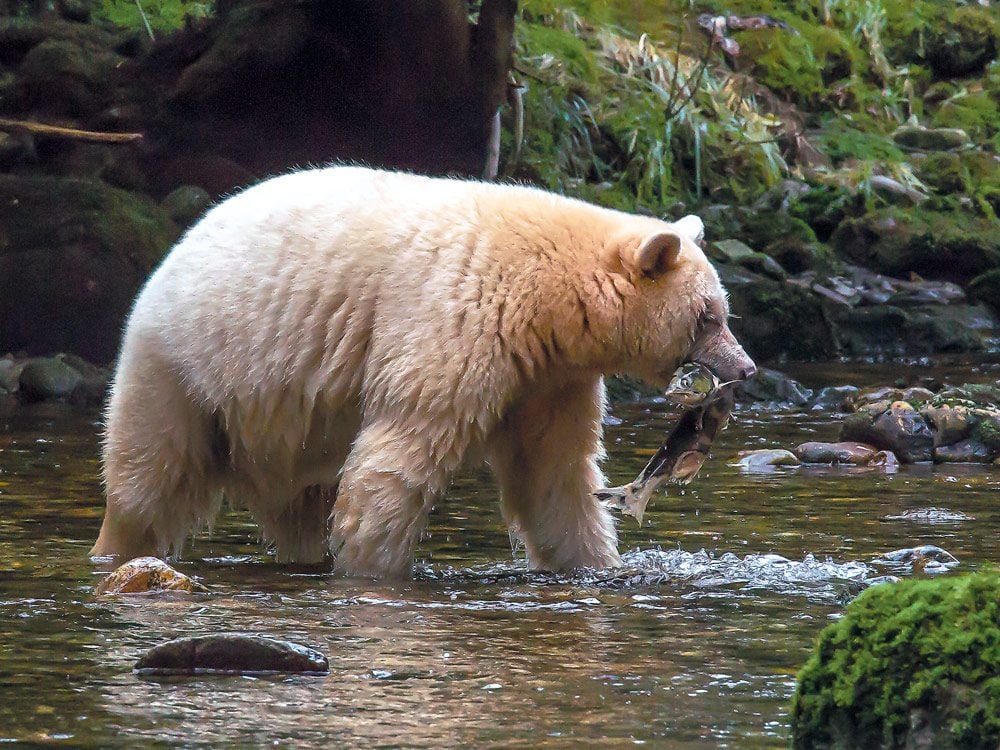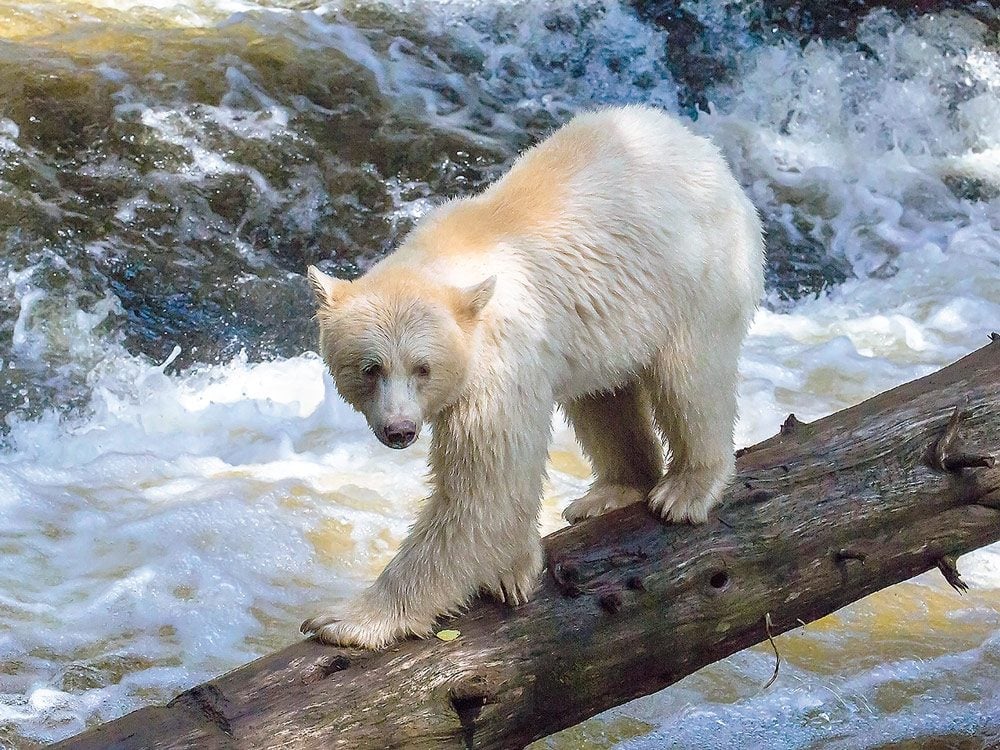
In Search of Spirit Bears
I hope my grandchildren and their grandchildren will be able to see B.C.’s Great Bear Rainforest (GBRF) as I have seen it. This thought kept running through my mind as our boat approached the dock at Bella Bella in October 2016, ending my first visit to the GBRF. I had just finished nine glorious days aboard Bluewater Adventures’ Island Roamer, a 68-foot sailboat carrying 12 passengers and a crew of four.
The GBRF is an area of 31,000 square kilometres that stretches along the central coast of British Columbia as far north as the Alaska border. It is the largest temperate rainforest in the world. Largely uninhabited, it is still possible to sail for hours without seeing any obvious signs of human presence.
The GBRF is home to the 1,000-year-old western red cedar and 300-foot Sitka spruce, as well as more than 1,800 salmon streams and rivers and amazingly abundant flora and fauna. Humpback and fin whales and orcas visit its waters along with Steller sea lions, harbour seals and five species of Pacific salmon. Bald eagles cruise the towering cliffs that line the shorelines and islands that make up the GBRF. It is also home to the rare kermode bear and even rarer spirit bear. The kermode bear is a subspecies of the American black bear. Its range is more or less limited to the area of the GBRF, so it is uniquely Canadian.
The kermode bear can have a very conspicuous genetic trait. When this genetic trait appears as a recessive gene, the bear has a white coat. Coastal First Nations Peoples have known of the presence of a white bear in coastal B.C. for many generations. When snow and ice covered the world, legend has it that Raven, creator of the world, chose to make the land lush and green. Raven then turned every 10th black bear white so people would remember the time of ice and snow. In the Tsimshianic languages, the name for this animal is moksgm’ol, meaning white bear. Today, a white-coated kermode bear is known as a spirit bear.
The current estimate of kermode bear numbers is around 1,200 with spirit bear numbers totalling perhaps 175 to 400. But no one knows for sure exactly how many exist. It is known that the greatest concentration of spirit bears occurs on Gribbell and Princess Royal islands in the GBRF. It was the chance to photograph a spirit bear that brought me to the GBRF. The chances of seeing a spirit bear are much improved in the fall season during the salmon runs. Bears, both black and grizzly, congregate along the salmon streams in the GBRF for their annual salmon feast.

Magical Moments
For the average traveller like me, there are only two ways to experience the GBRF and search for the rare and elusive spirit bear. One is through a small number of cruise-based adventure companies. The other is through the land-based Spirit Bear Lodge in Klemtu. In 2016, I deliberately chose a Bluewater Adventures trip that included two days of land-based bear viewing on Gribbell Island. Here we were led by the Gitga’ata People whose home is in nearby Hartley Bay. I returned to the GBRF in late summer 2017, staying at Spirit Bear Lodge in Klemtu on Swindle Island, home to the Kitasoo/Xai’xais People. As an amateur photographer, I had two amazing trips.
Remember, to see a spirit bear, you are on foot in an area about the same size as Vancouver Island hoping to see one of perhaps only 200 or so animals. What are the chances? On my two trips to the GBRF, I was lucky enough to catch glimpses of four different spirit bears. Two were only for a few brief seconds—not even long enough for a single photograph. But in 2016, I had one in my camera lens on Gribbell Island for almost three hours and in 2017 another one on Princess Royal Island for more than an hour. How lucky is that? It’s hard to put into words my feelings at that very first moment when a spirit bear appeared in front of me. We were at a bear viewing station on Gribbell Island. We knew it was there. Our Gitga’ata guides were tracking its movement as it headed upstream toward us. Some 20 photographers from two cruise-based adventure trips lined the stream edge, cameras ready.
Suddenly, it appeared, several hundred yards downstream from us, a spirit-like white figure against the green forest background. Our already quiet group stopped talking. The silence was broken only by the sound of gurgling water and the now-constant sound of clicking cameras. For the next three hours or so, the spirit bear slowly fished for salmon as it made its way toward and past our viewing station. At one point, it was less than ten feet away from us as it walked upstream in search of salmon.
At this time of the year, kermode bears are more or less habituated to the presence of humans along salmon streams being used for ecotourism. They seem to just go about their normal feeding activities without any undue stress. Our guides never carried any firearms but did carry bear spray, which never got used.
My second trip to the GBRF in 2017 was a land-based trip at Spirit Bear Lodge in Klemtu on Swindle Island. The lodge was built in 2008 by the Kitasoo/Xai’xais to enter the world of ecotourism. Each day, guests would head out in high-powered aluminum boats to pre-assigned viewing areas on one of the many salmon streams on Kitasoo/Xai’xais islands. We would travel as much as 90 minutes to our as signed area looking for humpback whales along the way.
On our first day out, we were taken to a stream on Princess Royal Island. We hiked a short distance along the stream edge through the rain soaked forest and then down a steep cliff to a rather small viewing area perhaps ten feet or so above the stream. We were in an area with a fairly large pool with several fallen trees spanning the stream as natural bridges. The rain had stopped and sunlight began to poke through the clouds and openings in the forest canopy. Dappled light created high contrast light and dark areas along the stream, making photography difficult. Meringue-like gobs of foam rushed down the stream or got stranded in the many back eddies along the shoreline.
After about an hour of patient waiting, our Kitasoo/Xai’xais boat driver radioed that a spirit bear was on the shore at the mouth of the stream. We all looked toward the sea, just visible from our viewing position. There it was, a spirit bear fishing pink salmon at the mouth of the stream.
I don’t think it would matter how many spirit bears I ever get to see, I expect the anticipation and excitement (including that initial adrenaline rush) will always be the same for me. Our guide hoped that the bear would work its way upstream to us. After catching and devouring a couple of salmon, it disappeared from view on the same side of the stream as we were.
Minutes began to seem like hours. As I looked up, the bear suddenly appeared on the same trail we had used to get to our viewing area. It was above us and perhaps 50 feet away, its white coat standing out against the green of the forest. It was one of those magic, almost fairy-tale type of moments that you dream of. I’m not sure if it looked at us. If it did, I missed that shot. Obviously it knew we were there. After pausing for just a few seconds, it made its way down the very steep slope to the stream and walked toward our position passing right below us.
For the next hour or more, the spirit bear feasted on pink salmon along the edges of the pool. It crossed back and forth using the fallen tree bridges before climbing the bank and vanishing silently into the forest.
Discover more hidden gems of B.C. worth exploring.

Close Encounters
On both trips, we stopped in the Fiordland Conservancy Area to photograph grizzly bears. Both times I was rewarded with amazing shots of numbers of grizzlies, including spotting a female grizzly with two cubs fishing for salmon. In 2017, I was standing barely 30 metres away as I watched a female grizzly in the stream catch a chum salmon and feed it to her cubs. After a few hours of fishing and feasting and always aware of the presence of nearby bears, she led her cubs up into the high grass that lined the edge of the stream. There she lay on her back and began to nurse her cubs. How many people get to watch and photograph a grizzly bear doing this in the wild?
People often ask how close I was to the bears. The best way I can answer is to say that if that female grizzly had decided to charge us, she would have been on us in three to four seconds at most.
Several of the coastal First Nations Peoples are beginning to reap the benefits of ecotourism. On my two trips to the GBRF, I met visitors from 10 different countries. Like me, all had come to experience the wonders of this place. Over time, it will be interesting to see how this shift to ecotourism will affect the GBRF. Hopefully, it will always remain an awe-inspiring place to go and experience firsthand all the magic that the region has to offer, including Canada’s unique spirit bear.
Next, explore the best wildlife experience in every province.